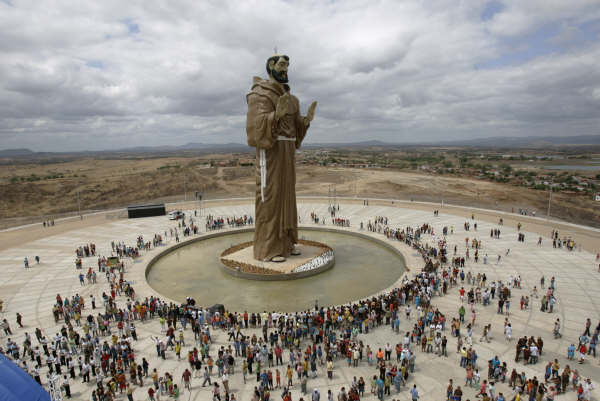Canindé, Ceará
Canindé is a city in northeastern Brazil, with approximately 74 thousand inhabitants, of whom half live in smaller settlements in the interior. From Fortaleza, the state capital of Ceará, you drive about 130 km to the west inland to reach this city. The city Canindé is known throughout the country as a place of pilgrimage of St. Francis of Assisi.
History
In 1764, this region was already populated and divided into smaller parcels. It was operated farming and livestock breeding. 1775, the town was officially founded by a Portuguese General, Francisco Xavier de Medeiros, to life. The city's name comes from there existing river, Rio Canindé. A small chapel was built in honor of St. Francis of Assisi. Great drought in the "Year of the triple seven" - 1777 - die in Canindé as in the whole state of Ceará hundreds of people. 1898, the chapel is passed to the Capuchins for further pastoral care. In 1914 Canindé given the status of a city. 2006, the inhabitants of the neighboring town Aratuba be recognized as descendants of the Indian tribe " Canindés ". In the same region of the tribe of Indians live genipapo.
Pilgrimage city
Every year hundreds of thousands of pilgrims come to Canindé to the worship of St. Francis of the wounds - under this name the pilgrims know him only for the initiated is Francis of Assisi. In the popular understanding of faith he is a saint, taking part in the lives of people living in Canindé where shelter him for the confreres. People like to thank the St. Francis in different ways for his intercession, or if you desire has occurred: you solve a promise to give money or bring with symbols representing a healed disease. These symbols - "It - Votus " vow called - are an indicator of how frequently occur certain diseases and allow conclusions about the social and psychological situation of the people: Head symbols represent strong concerns that cause headache and a headache: family problems, unemployment, etc.
Geographical embossing
The topography is characterized by mountainous formations, mountains and high-lying chains. These are rich to represent rocks formed by erosion, the monolith, which witnesses a geological past and are characterized by primitive inscriptions. The vegetation is a typical caatinga species. The fauna is represented by many bird species. The for the Northeast so typical scrubland and scrub forests ( the "dry caatinga " ) alternate with barren " Cerrado " steppes and rocky mountain landscapes - and then again influenced by the rainy season, green zone, the " Agreste ".
Climate
The average annual temperature is around 31 ° C, with maximum temperatures of 37 ° C and minimum temperatures of 24 ° C. The rain is common between the months of May to August. The rest of the year it is sunny and hot. The climate in the " Sertão " is hot and generally dry. In certain areas the annual rainfall is less than 500 mm, not unusual for a series of dry years without a drop of rain.









